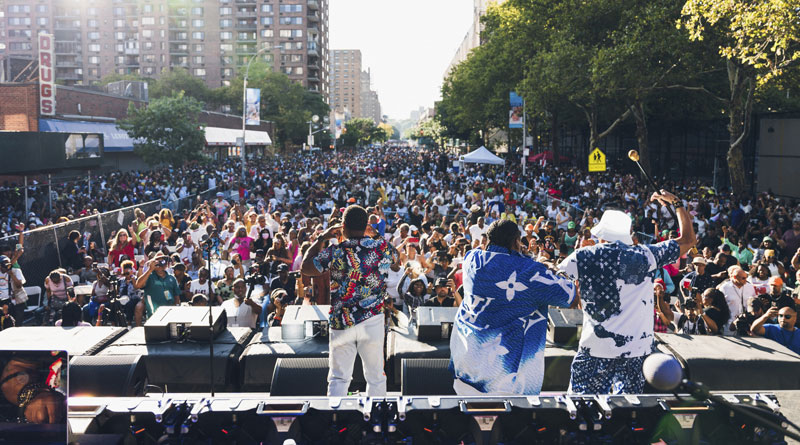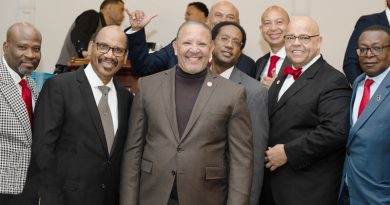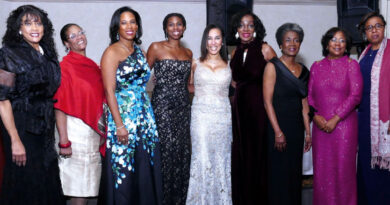HARLEM WEEK 50 AND BEYOND

By Ronald E. Scott
HARLEM WEEK debuted in the summer of 1974. It was conceived as a one-time only, one-day event (HARLEM DAY) organized by then Manhattan Borough President and Uptown Chamber of Commerce (now known as the Greater Harlem Chamber of Commerce) Board Chairman Hon. Percy Sutton. The one-day event was produced by Blackfrica Promotions, a Harlem-based arts and cultural organization whose key members included Joseph Roberts, Voza Rivers, Marvin Kelly, Larry Frazier, Tony Rogers, Stephanie Francis, and Lloyd Williams.
Actor, Director, and Activist Ossie Davis acknowledged Harlem Day as the beginning of the second Harlem Renaissance. “The day provided a much-needed spiritual boost for the entirety of Harlem,” he noted. Since its conception, HARLEM WEEK has metamorphosed into a month of activities, workshops, seminars, economic panels, a children’s village, and spelling bee. The annual outdoor festival has become one of the United States’ largest summer events, playing a significant role in building Harlem’s tourism market— responsible for millions of dollars each year being spent in the community.
HARLEM WEEK (HW) serves as a training ground for many of its young interns who have later become attorneys, doctors, teachers, executives, and entrepreneurs. Some of these students received HW scholarships that allowed them to attend major ivy league universities as well as HBCUs. HW also boosts a college fair where recruiters come from various HBCU’s and city, state, and ivy league colleges—giving parents and students opportunities for in-person conversations. The HW Youth Day Conference brings former interns to speak with students regarding their experiences and participation in various HW programs that impacted their success. On the other end of the age spectrum, Senior Citizens Day presents wellness and health conferences featuring dedicated community doctors who answer questions and discuss key health issues for seniors.
HW has always maintained relationships with elected officials from city, state, and federal government agencies from the Hon. Percy Sutton to Mayor David Dinkins and Mayor Eric Adams today. These ties have sparked political awareness in Harlem communities that inspires people to register and vote. HW has uplifted the spirits of Harlem residents and improved local economic status through supporting local businesses and offering college scholarships, internships, and jobs.
As one notices new construction sites throughout Harlem, GHCC and Harlem Week President Lloyd Williams (and his tourism team in the 1980s) can be credited for implementing those early discussions with the Department of Tourism in Washington, D.C. Now, years later we see new tourist commerce being generated on 125th Street with the Renaissance New York Harlem,which opened last year. Part of the Marriott chain, the 200-plus room hotel has become another source of income to the Central Harlem district.
The same 125th Street corridor is the new home of the Studio Museum in Harlem. The museum’s new five-story structure at 144 West 125th Street (designed by Ghanaian British architect Sir David Adjaye) has been closed since 2018 for a $175 million multiyear expansion project that will more than double its exhibition space. Additionally, The National Urban League (NUL) will have its headquarters half a block away. The NUL building will have approximately 175 units of affordable housing and will be a major commercial retail hub.
Also, under total reconstruction since 2021 is the revered Harlem institution, the National Black Theatre (NBT) at the intersection of 125th Street and Fifth Avenue. The 21-story project includes NBT’s multifloor space with a flexible 250-seat venue and a 99- seat studio theater, and plans for 222 units of mixedincome apartments and substantial commercial space along 125th Street. Sade Lythcott, CEO of National Black Theatre, praised her mother’s wisdom saying, “It took vision and a visionary like my mother, Dr. Barbara Ann Teer, to see into the future and what might be possible today.”
It is important to maintain the smaller businesses on the 125th Street corridor as well as those throughout the areas of East, Central, and West Harlem and lower Washington Heights from 96th Street to 168th Street from the East River to the Hudson.
Gentrification and residential displacement have happened more than once in New York City; during the Lincoln Square Renewal Project in the 1950s and 1960s, many families (including white, Puerto Rican, and Black residents) were displaced to make room for Lincoln Center. Unfortunately, this was the third time Black people had been shifted from their established neighborhoods. It happened in 1857 when mostly German, Irish, and Black residential landowners in Seneca Village were evicted through eminent domain to make room for Central Park. The second displacement was from the Tenderloin District to build Penn Station in 1910.
Controlling gentrification is a matter of being aware and making sure to accommodate the community. “We need to make sure we are not attracting people with significant disposable incomes. The people who have weathered the storm and stayed here all along become the victims who are no longer able to afford to live inHarlem,” noted Williams in an AM NY article. “That’s a measurement we are aggressively working with the city, the state, and the developers so whenever they are building something, there is a significant portion deemed affordable housing.”
Over the years, HARLEM WEEK has diligently developed an infrastructure that has assisted in repaving streets and restoring NYC parks that became permanent structures for the community to use and enjoy. Such progress will continue as businesses, activists, residents, and organizations come together and play an active role in the progress of HW and its many facets that open doors for residents of Harlem.


